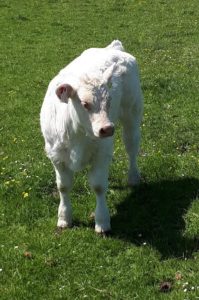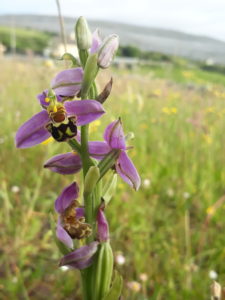This article first appeared on ARC2020.eu. ARC2020 is a platform for agri-food and rural actors working towards better food, farming, and rural policies for Europe.
We’re back with Shane Casey in The Burren, where it’s been a good Spring. Family and farm are thriving. For Shane, nature conservation and productivity go hand in hand. As the debate rages around the EU Nature Restoration Law, he is sympathetic to the farmers who are being asked to undo a lifetime of ‘improvements’ to make space for nature.
A new baby in the house has the tendency to make time disappear, and pushes most other things to the very back of your mind, so my apologies that it has been almost a year since my last letter – but what a year it’s been!
Let me take you back to the beginning of this year… what makes a ‘good’ Spring?
For a tillage farmer, it’s the right balance of weather conditions to get their crops planted and growing. For a dairy farmer, it’s a flush of new grass growth at the right time to get their milk yield up. And for a suckler or sheep farmer, like our farm at home, it’s not suffering any losses during the lambing or calving periods, neither the newborns nor their mothers. It gets better again if you have no need to call a vet for a caesarean section, and no outbreak of disease or ailments.
Grass growing at a rate of knots
In so many aspects of farming, we rely on things that are outside of our control. We can only hope that, over a lifetime, the good Springs greatly outweigh the bad ones. Thankfully, it was a great Spring on our farm, and the Summer so far, touch wood, is shaping up well.
The weather in early May had the grass growing at a rate of knots, almost too fast for the cows and sheep to keep up with, which was a nice complaint to have. But you can have too much of a good thing, and as we head into June, we’re in need of some rain, or things could change very rapidly. Of course, generally speaking, we’re blessed here in Ireland to have a temperate climate, with extremes in weather a rarity, although they are increasing in frequency and intensity as a result of climate change. But when you hear of the challenges faced by farmers from around Europe and the wider world, driven by extreme weather events brought about by climate change, you tend to count your blessings!
The cattle and sheep have, of course, been moved off the winterage ground at this stage. First, they were moved to the row of green fields (what we call the gardens, because they once were) between Blackhead Mountain and Galway Bay, but these have now been closed off to make hay (or haylage failing this).
They are now in the sloping green meadows of the Caher Valley, between Blackhead Mountain and Slieve Elva mountain, and will stay there, all going well, until the Autumn.
Lambs and calves thriving

Calf thriving! Photo: Shane Casey.
After a hectic Spring, it’s lovely to see the lambs and calves thriving. It’s a force of habit, after a childhood spent bringing animals to agricultural shows, to look at the calves to see if they have the potential to compete. Or indeed, if the heifer calves have the potential to be kept as breeding replacements. Many of the calves are already grazing grass, while others are just basking in the sunshine, with their mothers close by with full udders of milk.
As for the lambs, it only takes around sixteen weeks for a lamb to go from birth to butcher-ready, so you can almost see them grow day by day at this time of year. The early season lambs have recently been weaned, with the youngest of the mid-season lambs due to be weaned in the coming weeks.
Weaning for us usually coincides with shearing – it’s easier to do it all in the one go, rather than gathering them a second time. The ewes are either kept inside, if we’ve managed to clean the shed in time, or outside in a clean bare paddock for a few days after weaning to dry them off. They are then let over to Tra na Gan – a field of limestone pavement beside the house, which is the same type of habitat as the winterage, but managed a little differently because of its accessibility.
The Burren in bloom

Bee Orchid at Blackhead Mountain. Photo: Shane Casey
Of course, the need to check up on these ewes every so often, gives us an excuse to be on the limestone pavements during the summer, and experience the full scale of the Burren in bloom. Walking from our house, the first flowers you’ll meet are the bloody cranesbills and burnet rose, quickly followed by birds-foot trefoil and rockrose. You’ll have to climb Blackhead Mountain a little further, but not by much, to find spring gentians and early purple orchids, and further still to find mountain avens. By that stage you’ll be tripping over all sorts of flowers that make the Burren so special – even the rare Irish orchid.
As I’ve mentioned in previous letters, our way of farming in the Burren, and particularly our unique practice of winterage, is the quintessential example of farming for conservation. Farmers across the Burren have undertaken many actions to improve the conservation value of their farms, but it should be acknowledged that many of these actions simultaneously improved the productivity or efficiency of their farm enterprises.
To Hell or to Connaught
This is quite different from the experiences of farmers elsewhere who often have to choose between productivity and conservation, and such a fundamental decision will likely be a significant challenge facing the forthcoming EU Nature Restoration law. In Ireland, this decision is further complicated by our history, with the ‘rewetting’ of land being a particularly controversial topic at the moment.
“To Hell or to Connaught” is a phrase that every Irish child will have encountered in primary school, and refers to the threat issued to Irish people a few hundred years ago by British colonist, Oliver Cromwell. Connaught, one of our four provinces in Ireland, contains some of the wettest agricultural land in the country, and a death sentence was being offered as an alternative to trying to eke out a living alongside millions of other displaced Irish Catholics.
A hard pill to swallow
Fast-forward a few hundred years, to the mid-20th century, when land ownership across the eastern half of Ireland had been returned to the Irish. There were now state supported initiatives to ‘improve’ land for agriculture through drainage. Such improvements weren’t restricted to Ireland, of course, with ‘best practice’ in agriculture elsewhere frequently promoting such improvements.
Now consider a farmer in their fifties or sixties, whose parents or grandparents would have told them stories about the hardships of the past, before modern technology and know-how was available – we’ve all heard such stories, and consequently have an in-built fear of what taking a backwards step might entail! Then, for most of their farming career, that farmer would have been encouraged to improve, improve, improve, by agricultural experts (who unfortunately have been slow to acknowledge, let alone apologise for, the things they got wrong). And the farmer listened, and did everything they were told. If their grandparents could see the farm now, they mightn’t even recognise it.
Are they now being asked to undo a lifetime of work, and not just their own, but the labours of previous generations – to take that backwards step? It may be the right thing to do, but a hard pill to swallow nonetheless.
How can policy support Shane’s farming for conservation practices?
For millennia, farmers in the Burren have played a central role in supporting the rich biodiversity and cultural heritage of the region.
In the 20th century, under the influence of global, political and technological forces, the Burren’s traditional farming systems radically changed. These changes upset the precious balance between farming and the local environment (as Brendan Dunford details in Farming and the Burren).
Rather than continue on this well-trodden trajectory, partners from a local farming organisation, the research community and two state agencies came together and secured EU LIFE funding to develop ‘A blueprint for sustainable agricultural management of the Burren’.
This was the first iteration of what came to be known as the Burren Programme, a trailblazing farming for conservation initiative that championed farmers as a resource in the sustainable agricultural management of priority habitats. It is recognised across the EU as a case-in-point for the positive impact that well-designed and implemented agri-environmental schemes can have ecologically, socially, culturally and economically.
The Burren Programme employed a locally-led results-based payment system to incentivise farmers to improve biodiversity, water quality and cultural heritage on their land.
Participating farmers were paid for the conservation actions they undertook as well as for the scores they achieved in field-based assessments. The higher a field scored, the higher the results-based payment. Fields were graded on the basis of 10 criteria including grazing level, ecological integrity and natural water source damage.
The Burren Programme came to an end at the end of 2022, and is replaced in Ireland’s CAP Strategic Plan with the ACRES Burren Aran Cooperation Project.
There are concerns among those who led the Burren Programme that despite some positive developments, its successor falls short when it comes to payment structures, the lack of flexibility for local teams to manage budgets and programmes, and the workload of advisors. Brendan Dunford who managed the Burren Programme said in relation to the new scheme, “While scaling is positive it can’t be done at the expense of impact. ”
Shane Casey, who participated in the Burren Programme and its previous incarnations, evokes a farming analogy to illustrate his concerns around its ending and successor:
“When buying in replacement breeding stock, you always want to get something as good as, and preferably better, than what you already have at home. Always strive for the best, and not just the ‘good enough’… It’s understandable that policymakers would prefer a ‘one size fits all’ approach for consistency, equality, transparency, etc. (it’s worth noting that these things often mean more to us than they do to conservation), however, such an approach is not a perfect fit for anyone. When you have a landscape of such high conservation value as the Burren, you want a perfect fit (The Burren Programme), and anything less (The ACRES Burren-Aran Co-operation Project – albeit with many good elements) is a backwards step for conservation.”
Teaser photo credit: Hereford-Charolais cross twins thriving on Shane Casey’s farm. Photo: Shane Casey





